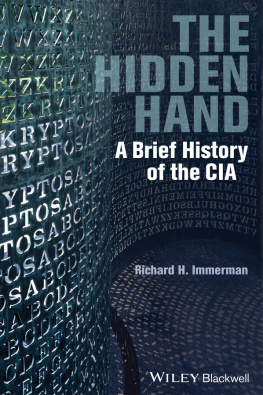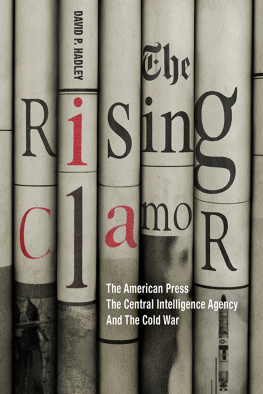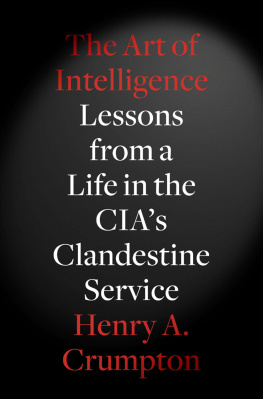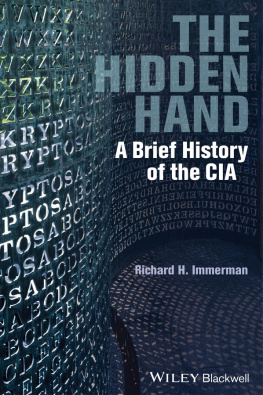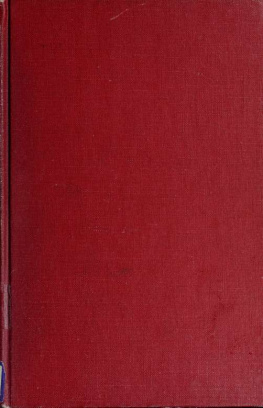
This edition first published 2014
2014 John Wiley & Sons Inc.
Registered Office
John Wiley & Sons Ltd, The Atrium, Southern Gate, Chichester, West Sussex, PO19 8SQ, UK
Editorial Offices
350 Main Street, Malden, MA 02148-5020, USA
9600 Garsington Road, Oxford, OX4 2DQ, UK
The Atrium, Southern Gate, Chichester, West Sussex, PO19 8SQ, UK
For details of our global editorial offices, for customer services, and for information about how to apply for permission to reuse the copyright material in this book please see our website at www.wiley.com/wiley-blackwell.
The right of Richard H. Immerman to be identified as the author of this work has been asserted in accordance with the UK Copyright, Designs and Patents Act 1988.
All rights reserved. No part of this publication may be reproduced, stored in a retrieval system, or transmitted, in any form or by any means, electronic, mechanical, photocopying, recording or otherwise, except as permitted by the UK Copyright, Designs and Patents Act 1988, without the prior permission of the publisher.
Wiley also publishes its books in a variety of electronic formats. Some content that appears in print may not be available in electronic books.
Designations used by companies to distinguish their products are often claimed as trademarks. All brand names and product names used in this book are trade names, service marks, trademarks or registered trademarks of their respective owners. The publisher is not associated with any product or vendor mentioned in this book.
Limit of Liability/Disclaimer of Warranty: While the publisher and author have used their best efforts in preparing this book, they make no representations or warranties with respect to the accuracy or completeness of the contents of this book and specifically disclaim any implied warranties of merchantability or fitness for a particular purpose. It is sold on the understanding that the publisher is not engaged in rendering professional services and neither the publisher nor the author shall be liable for damages arising herefrom. If professional advice or other expert assistance is required, the services of a competent professional should be sought.
Library of Congress Cataloging-in-Publication Data is available for this title
ISBN 9781444351361 (hardback); ISBN 9781444351378 (paperback)
A catalogue record for this book is available from the British Library.
Cover image: Detail of Kryptos sculpture by Jim Sanborn in grounds of C.I.A. headquarters, Langley, Virginia. Photo from Carol M. Highsmith Archive, Library of Congress, Prints and Photographs Division.
Cover design by Simon Levy
To Anna, whom I hope will grow up in a world of greater transparency as well as security.
Preface and Acknowledgments
This is a short book with a long history. The number of debts I have accumulated along the way is therefore also long. The list begins with Walt LaFeber and Arnie Offner. Walt was almost solely responsible for shifting my interests from political science (government at Cornell) to history, specifically the history of US foreign relations. What is more, he provoked my curiosity about Latin America, particularly Central America. My decision to write my dissertation on the Central Intelligence Agency (CIA) intervention in Guatemala, accordingly, was a logical progression. The problem was that writing in the 1970s a history of a covert operation was highly illogical. There were no archives or, for that matter, documentation of any kind. As a graduate student, I received encouragement only from my faculty advisor, but he died. I then turned to Arnie Offner. Arnie, although at another university, believed in the project. More important, he believed in me. Under Arnie's guidance, I wrote my dissertation. It became a book, The CIA in Guatemala.
By the time of the book's publication, I had become a historian of intelligence, although I did not realize that I had. I continued to dabble in the subject over the subsequent years, but only dabble. Without fully appreciating the implications, during these same years I revived my interest in political science. Fred Greenstein and Bob Jervis are the reasons. Fred became the kind of mentor one never expects after completing the PhD. He introduced me to the literature on personality and politics, advising, and decision making. He also introduced me to Bob. Bob has no peer when it comes to applying theories of cognitive psychology to the study of international relations. He also has no peer as a scholar of intelligence. He inspired me in both spheres.
Athan Theoharis was the catalyst for my synthesizing these early influences and interests and finally admitting that I wanted to concentrate my writing on the CIA and the Intelligence Community. I knew Athan only by reputation. He of course is renowned for his scholarship on domestic surveillance, civil liberties, and the FBI. When he contacted me shortly after the 9/11 tragedy, however, it was to invite me to contribute to a collection of essays on the CIA. Athan wanted me to write a lengthy overview of the agency's history. All of the contributors would be co-editors.
I accepted Athan's invitation, and my Brief History of the CIA came out in 2006 as the first chapter of The Central Intelligence Agency: Security under Scrutiny. I took great pleasure in writing it, and it serves as the foundation of this book. The essay provided me with the opportunity to evaluate the CIA through a much broader lens than operations. I examined its origins and evolution over time, its relations with other elements in the Intelligence Community, the problems produced by the tensions inherent in its roles and missions, and more. Still, the project was as frustrating as it was exciting. I very much enjoy the challenge of trying to capture vast swaths of history in relatively few words. But an 80-page history of the CIA was a bridge too far.
Enter Peter Coveney into my story. Peter is a terrific editor with Wiley-Blackwell, a long-time favorite of many of us who boast of our membership in the Society for Historians of American Foreign Relations. I have no idea how many people read my Brief History. I would bet very few. But Peter was one, and he thought it had the makings of a book. We struck a deal, and I can't thank Peter enough for making it happen. The Hidden Hand not only was his idea, but I also benefited from his advice, editing, and attention from beginning to end. And I also benefited from those at Wiley-Blackwell whom Peter recruited to help me. Specifically, I must thank my copy editor, Jamila Niroop, and Annette Musker, who compiled the index, and Georgina Coleby, who managed the manuscript through production.
Peter was very patient with me. He had to be. That's because in 2007 the book, my career, and my life turned in a very unexpected direction. Thanks in large part to the late Nancy Bernkopf Tucker, a dear friend, distinguished scholar, and committed citizen, I was asked to come to Washington to serve as assistant deputy director of intelligence for analytic integrity and standards and analytic ombudsman for the Office of the Director of National Intelligence (ODNI). I was stunned. I had just returned to Temple from leave, I was finishing one book and had promised Peter I'd start on this one, and I had never, ever considered government work. But accepting was one of the smartest decisions I ever made. Leaving aside any assessments of my performance, I cannot exaggerate the new insights on the entire intelligence enterprise I gained during my eighteen-month tenure in the ODNI and the extent to which my appreciation for the dedication and capabilities of my coworkers grew. For this most rewarding and educational experience, I have my entire office to thank: Jim Marchio, Scott McCall, Karl Pieragostini, Kyle Rector, Steve Rieber, Glen Simpers, Jeff Stillman, Becky Strode, and Linda Whitehurst. I owe a special debt to my boss, Tom Fingar, the deputy director of national intelligence for analysis. As far as I am concerned, no one knows more than Tom about the finer points of intelligence. And no one is a better leader, or in my case, a better teacher.
Next page
